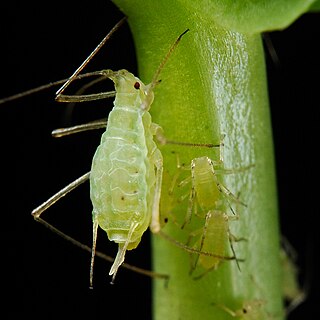 W
WAcyrthosiphon pisum, commonly known as the pea aphid, is a sap-sucking insect in the family Aphididae. It feeds on several species of legumes worldwide, including forage crops, such as pea, clover, alfalfa, and broad bean, and ranks among the aphid species of major agronomical importance. The pea aphid is a model organism for biological study whose genome has been sequenced and annotated.
 W
WThe Agromyzidae are a family commonly referred to as the leaf-miner flies, for the feeding habits of their larvae, most of which are leaf miners on various plants.
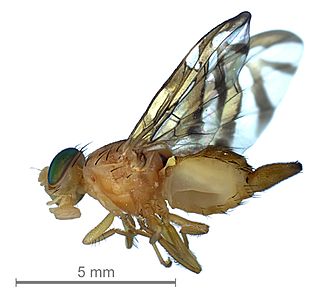 W
WAnastrepha obliqua is a species of fruit fly. It is the most important fruit fly pest of mangoes in Neotropics and attacks a wide range of other spicy fruits. A. obliqua is widespread in Mexico, Central and South America and the West Indies. It is sometimes called the West Indian fruit fly in English.
 W
WThe Anthomyiidae are a large and diverse family of Muscoidea flies. Most look rather like small houseflies, but are commonly drab grey. The genus Anthomyia, in contrast, is generally conspicuously patterned in black-and-white or black-and-silvery-grey. Most are difficult to identify, apart from a few groups such as the kelp flies that are conspicuous on beaches.
 W
WAphids are small sap-sucking insects and members of the superfamily Aphidoidea. Common names include greenfly and blackfly, although individuals within a species can vary widely in color. The group includes the fluffy white woolly aphids. A typical life cycle involves flightless females giving living birth to female nymphs—who may also be already pregnant, an adaptation scientists call telescopic development—without the involvement of males. Maturing rapidly, females breed profusely so that the number of these insects multiplies quickly. Winged females may develop later in the season, allowing the insects to colonize new plants. In temperate regions, a phase of sexual reproduction occurs in the autumn, with the insects often overwintering as eggs.
 W
WA bark beetle is one of about 6,000 species in 247 genera of beetles in the subfamily Scolytinae. Previously, this was considered a distinct family (Scolytidae), but is now understood to be specialized clade of the "true weevil" family (Curculionidae). Although the term "bark beetle" refers to the fact that many species feed in the inner bark (phloem) layer of trees, the subfamily also has many species with other lifestyles, including some that bore into wood, feed in fruit and seeds, or tunnel into herbaceous plants. Well-known species are members of the type genus Scolytus, namely the European elm bark beetle S. multistriatus and the large elm bark beetle S. scolytus, which like the American elm bark beetle Hylurgopinus rufipes, transmit Dutch elm disease fungi (Ophiostoma). The mountain pine beetle Dendroctonus ponderosae, southern pine beetle Dendroctonus frontalis, and their near relatives are major pests of conifer forests in North America. A similarly aggressive species in Europe is the spruce ips Ips typographus. A tiny bark beetle, the coffee berry borer, Hypothenemus hampei is a major pest on coffee plantations around the world.
 W
WThe beet leafhopper, also sometimes known as Neoaliturus tenellus, is a species of leafhopper which belongs to the family Cicadellidae in the order Hemiptera.
 W
WBrevicoryne brassicae, commonly known as the cabbage aphid or cabbage aphis, is a destructive aphid native to Europe that is now found in many other areas of the world. The aphids feed on many varieties of produce, including cabbage, broccoli (especially), Brussels sprouts, cauliflower and many other members of the genus Brassica, but do not feed on plants outside of the family Brassicaceae. The insects entirely avoid plants other than those of Brassicaceae; even though thousands may be eating broccoli near strawberries, the strawberries will be left untouched.
 W
WCacopsylla melanoneura is an insect of the Psyllidae family. It mainly feeds on Hawthorn. The insect will also feed on apple trees and is considered the main vector of the phytoplasma disease "Ca. Phytoplasma mali" in northwestern Italy.
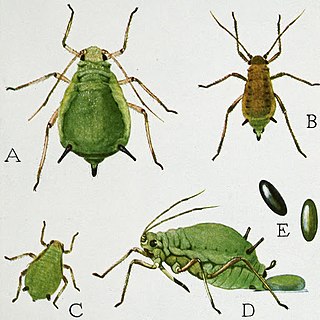 W
WChaetosiphon fragaefolii, the strawberry aphid, is a bug species in the genus Chaetosiphon found in the United States (Arizona), Argentina and Chile.
 W
WThe common brown leafhopper, Orosius orientalis (Matsumura) is one of the most common species of Australian leafhoppers with a very wide host range. It is an important vector of several viruses and phytoplasmas worldwide. In Australia, phytoplasmas vectored by O. orientalis cause a range of economically important diseases including legume little leaf, tomato big bud, lucerne witches broom, potato purple top wilt, Australian lucerne and the insect is a possible vector of Australian grapevine yellows. O. orientalis also transmits Tobacco yellow dwarf virus to beans, causing bean summer death disease and to tobacco, causing tobacco yellow dwarf disease.
 W
WThe Curculionidae are the family of the "true" weevils. They are one of the largest animal families, with 6,800 genera and 83,000 species described worldwide. They are the sister group to the subfamily Brentidae
 W
WDiabrotica balteata is a species of cucumber beetle in the family Chrysomelidae known commonly as the banded cucumber beetle. It occurs in the Americas, where its distribution extends from the United States to Colombia and Venezuela in South America. It is also present in Cuba. It is a pest of a variety of agricultural crops.
 W
WFrankliniella tritici, the eastern flower thrips, is a species of thrips in the genus Frankliniella. F. tritici inhabits blossom, such as dandelion flowers. They can directly damage plants, grasses and trees, in addition to commercial crops, and as a vector for tospoviruses, a form of plant virus, it particularly affects small fruit production in the United States, including strawberries, grapes, blueberries and blackberries. It can also affect alfalfa, oats, beans and asparagus crops. The species features strap-like wings edged with long hairs, a design which increases aerodynamic efficiency in very small arthropods; the reduced drag means the insect uses less energy. They extract nutrients directly from individual plant cells, and may also digest cells of fungi in the leaf litter.
 W
WThe glassy-winged sharpshooter is a large leafhopper insect from the family Cicadellidae, similar to other species of sharpshooter.
 W
WHyalesthes obsoletus is a bug species in the genus Hyalesthes.
 W
WHylastes ater is a species of beetle in the family Curculionidae, the true weevils. It is a bark beetle, a member of the subfamily Scolytinae. Its common name is the black pine bark beetle. It is native to Europe and parts of Asia, including China and Korea. It is known as an introduced species in many other regions, including Australia, New Zealand, the Americas, and South Africa. It is a pest of pines and other trees, and it is widespread in areas where pine trees are cultivated. The species "is an important threat to the biosecurity of all forested countries."
 W
WThe insects of the beetle family Chrysomelidae are commonly known as leaf beetles, and include over 37,000 species in more than 2,500 genera, making up one of the largest and most commonly encountered of all beetle families. Numerous subfamilies are recognized, but the precise taxonomy and systematics are likely to change with ongoing research.
 W
WA leafhopper is the common name for any species from the family Cicadellidae. These minute insects, colloquially known as hoppers, are plant feeders that suck plant sap from grass, shrubs, or trees. Their hind legs are modified for jumping, and are covered with hairs that facilitate the spreading of a secretion over their bodies that acts as a water repellent and carrier of pheromones. They undergo a partial metamorphosis, and have various host associations, varying from very generalized to very specific. Some species have a cosmopolitan distribution, or occur throughout the temperate and tropical regions. Some are pests or vectors of plant viruses and phytoplasmas. The family is distributed all over the world, and constitutes the second-largest hemipteran family, with at least 20,000 described species.
 W
WLipaphis erysimi is a species of aphid of the family Aphididae. Its common names include mustard aphid and turnip aphid. It is found in most temperate and tropical areas of the world and feeds only on cruciferous plants. The insects are almost exclusively female and are very prolific, with wingless females producing around one hundred young during a lifespan of a few weeks.
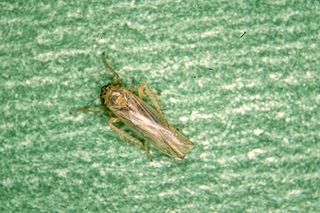 W
WMacrosteles quadrilineatus, the aster leafhopper or six-spotted leafhopper, is a leafhopper species in the genus Macrosteles, found in the United States. It is the vector of aster yellows disease, which affects various vegetable plants, weeds and ornamental plants.
 W
WMealybugs are insects in the family Pseudococcidae, unarmored scale insects found in moist, warm habitats. Many species are considered pests as they feed on plant juices of greenhouse plants, house plants and subtropical trees and also act as a vector for several plant diseases. Some ants, however live in symbiotic relationships with them.
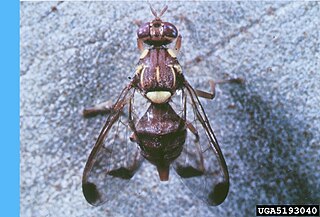 W
WThe melon fly (Bactrocera cucurbitae) is a fruit fly of the family Tephritidae. It is a serious agricultural pest, particularly in Hawaii.
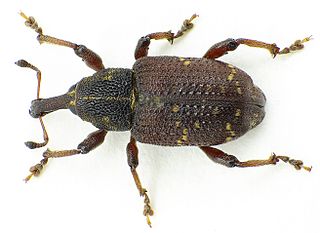 W
WMolytinae is a subfamily of weevils described by Carl Johan Schönherr in 1823.
 W
WPegomya hyoscyami, the beet leafminer or spinach leafminer, is a grey fly about 6 millimetres (0.24 in) long. It emerges in April–May and lays eggs on the undersides of leaves of beet, spinach, chard, and other greens. Eggs develop into larvae that burrow into the leaf hollowing out large patches of the leaf between leaf surfaces, often killing large parts of the leaf.
 W
WPissodes is a genus of weevils described by Ernst Friedrich Germar in 1817.
 W
WPissodes strobi, known as the white pine weevil or Engelmann spruce weevil, is the primary weevil attacking and destroying white pines. It was described in 1817 by William Dandridge Peck, professor of natural history and botany at Harvard University. The weevil is dark brown with white spots and is native to North America.
 W
WPissodini is a tribe of weevils described by Johannes von Nepomuk Franz Xaver Gistel in 1856.
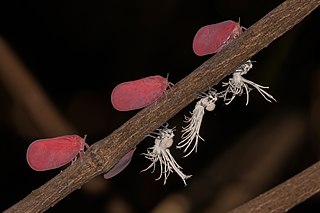 W
WA planthopper is any insect in the infraorder Fulgoromorpha, in the suborder Auchenorrhyncha, and exceeding 12,500 described species worldwide. The name comes from their remarkable resemblance to leaves and other plants of their environment and from the fact that they often "hop" for quick transportation in a similar way to that of grasshoppers. However, planthoppers generally walk very slowly. Distributed worldwide, all members of this group are plant-feeders, though surprisingly few are considered pests. The infraorder contains only a single superfamily, Fulgoroidea. Fulgoroids are most reliably distinguished from the other Auchenorrhyncha by two features; the bifurcate ("Y"-shaped) anal vein in the forewing, and the thickened, three-segmented antennae, with a generally round or egg-shaped second segment (pedicel) that bears a fine filamentous arista.
 W
WPseudococcus viburni is a close relative of the grape mealybug and a pest of the vineyards of New Zealand, the Central Coast of California, and the tea gardens of northern Iran. Unlike the grape mealybug, the obscure mealybug is not native to California, having most likely been introduced to the region from either Australia or South America in the latter part of the 19th century.
 W
WPsylla pyri, commonly known as the pear psylla or pear psyllid, is a true bug in the family Psyllidae. Originating in Europe and Asia, it has spread to North America. It is a pest of pear trees, sucking the sap, damaging the foliage, flowers and fruit and diminishing the crop.
 W
WPsyllidae, the jumping plant lice or psyllids, are a family of small plant-feeding insects that tend to be very host-specific, i.e. each plant-louse species only feeds on one plant species (monophagous) or feeds on a few closely related plants (oligophagous). Together with aphids, phylloxerans, scale insects and whiteflies, they form the group called Sternorrhyncha, which is considered to be the most "primitive" group within the true bugs (Hemiptera). They have traditionally been considered a single family, Psyllidae, but recent classifications divide the group into a total of seven families; the present restricted definition still includes more than 70 genera in the Psyllidae. Psyllid fossils have been found from the Early Permian before the flowering plants evolved. The explosive diversification of the flowering plants in the Cretaceous was paralleled by a massive diversification of associated insects, and many of the morphological and metabolic characters that the flowering plants exhibit may have evolved as defenses against herbivorous insects.
 W
WRhopalosiphum rufiabdominale, the rice root aphid or red rice root aphid, is a sap-sucking insect pest with a wide host range and a global distribution. As a member of the superfamily Aphidoidea, it is one of 16 species of the genus Rhopalosiphum. Adults and nymphs are soft-bodied and usually dark green with brown, red, or yellow tones. Like all aphids, reproduction is sexual and asexual, depending on the environmental conditions and host plant. Rice root aphids cause injury to external plant parts, namely the roots or stem, by feeding on plant sap and vector several important plant viruses. The hosts of this pest extend across multiple plant families with most belonging to Rosaceae, Poaceae, and Solanaceae. R. rufiabdominale is universally associated with Prunus species but also infests various field crops, greenhouse vegetables, cannabis, and other ornamental plants. While this aphid originates from east Asia, it spans nearly every continent. Dispersal is particularly widespread across the United States, India, and Australia, with crop damage documented in multiple instances, although economic losses are primarily associated with Japanese rice crops. Nonetheless, it remains a pest of serious concern due to its high mobility, discrete habitat, and adaptive plasticity, giving it the rightful reputation as a successful invader.
 W
WThe South American palm weevil, Rhynchophorus palmarum, is a species of snout beetle. The adults are relatively large black beetles of approximately one and a half inch in length, and the larvae may grow to two inches in length.
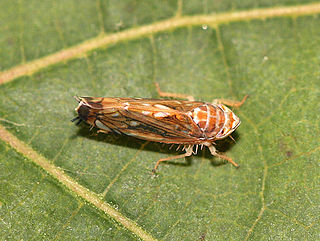 W
WScaphoideus titanus, or the American grapevine leafhopper, is an insect of the leafhopper family (Cicadellidae) which feeds on various plants of the family Vitaceae. Native to North America, it was introduced by accident to Europe where it has become a pest by acting as a vector of the grapevine phytoplasma disease flavescence dorée.
 W
WThe chilli thrips or yellow tea thrips, Scirtothrips dorsalis Hood, is an extremely successful invasive species of pest-thrips which has expanded rapidly from Asia over the last twenty years, and is gradually achieving a global distribution. It has most recently been reported in St. Vincent (2004) Florida (2005), Texas (2006), and Puerto Rico (2007). It is a pest of economic significance with a broad host range, with prominent pest reports on crops including pepper, mango, citrus, strawberry, grapes, cotton, tea, peanuts, blueberry, and roses. Chilli thrips appear to feed preferentially on new growth, and infested plants usually develop characteristic wrinkled leaves, with distinctive brown scarring along the veins of leaves, the buds of flowers, and the calyx of fruit. Feeding damage can reduce the sale value of crops produced, and in sufficient numbers, kill plants already aggravated by environmental stress. This thrips has also been implicated in the transmission of three tospoviruses, but there is some controversy over its efficiency as a vector.
 W
WThe silverleaf whitefly is one of several species of whitefly that are currently important agricultural pests. A review in 2011 concluded that the silverleaf whitefly is actually a species complex containing at least 40 morphologically indistinguishable species.
 W
WThe Tephritidae are one of two fly families referred to as fruit flies, the other family being the Drosophilidae. The family Tephritidae does not include the biological model organisms of the genus Drosophila, which is often called the "common fruit fly". Nearly 5,000 described species of tephritid fruit fly are categorized in almost 500 genera of the Tephritidae. Description, recategorization, and genetic analyses are constantly changing the taxonomy of this family. To distinguish them from the Drosophilidae, the Tephritidae are sometimes called peacock flies, in reference to their elaborate and colorful markings. The name comes from the Greek τεφρος, tephros, meaning "ash grey". They are found in all the biogeographic realms.
 W
WThe Thripidae are the most speciose family of thrips, with over 290 genera representing just over two thousand species. They can be distinguished from other thrips by a saw-like ovipositor curving downwards, narrow wings with two veins, and antennae of six to ten antennomeres with stiletto-like forked sense cones on antennal segments III and IV.
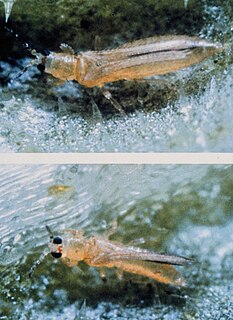 W
WThrips palmi is an insect from the genus Thrips in the order Thysanoptera. It is known commonly as the melon thrips.
 W
WTomicus piniperda is a bark beetle native throughout Europe, northwestern Africa, and northern Asia. It is one of the most destructive shoot-feeding species in northern Europe.
 W
WToxoptera citricida is a species of aphid known by the common names brown citrus aphid, black citrus aphid, and oriental citrus aphid. It is a pest of citrus and vector for the pathogenic plant virus citrus tristeza virus. The aphid spread the virus through citrus groves in Brazil and Venezuela in the 1970s, leading to the near destruction of the citrus industry there. This aphid was first discovered in Florida in 1995.
 W
WTreehoppers and thorn bugs are members of the family Membracidae, a group of insects related to the cicadas and the leafhoppers. About 3,200 species of treehoppers in over 400 genera are known. They are found on all continents except Antarctica; only five species are known from Europe. Individual treehoppers usually live for only a few months.
 W
WTriozidae is one of seven families collectively referred to as jumping plant lice. They have traditionally been considered part of a single family, Psyllidae, but recent classifications divide the group into a total of seven families; most of the genera remain in the Psyllidae, but Triozidae is the second-largest family in the group, containing 27 genera, and a number of pest species.
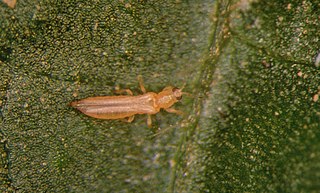 W
WThe western flower thrips [Frankliniella occidentalis (Pergande)] is an invasive pest insect in agriculture. This species of thrips is native to the Southwestern United States but has spread to other continents, including Europe, Australia, and South America via transport of infested plant material. It has been documented to feed on over 500 different species of host plants, including a large number of fruit, vegetable, and ornamental crops. The adult male is about 1 mm long; the female is slightly larger, about 1.4 millimetres in length. Most western flower thrips are female and reproduce by arrhenotokous parthenogenesis; i.e. females can produce males from unfertilized eggs, but females arise only from fertilized eggs. Males are rare, and are always pale yellow, while females vary in color, often by season, from red to yellow to dark brown. Each adult is elongated and thin, with two pairs of long wings. The eggs are oval or kidney-shaped, white, and about 0.2 mm long. The nymph is yellowish in color with red eyes.
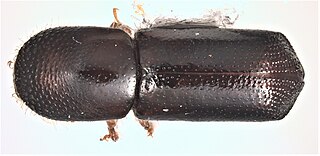 W
WXyleborus glabratus is a type of ambrosia beetle invasive in the United States. It has been documented as the primary vector of Raffaelea lauricola, the fungus that causes laurel wilt, a disease that can kill several North American tree species in the family Lauraceae, including redbay, sassafras, and avocado.